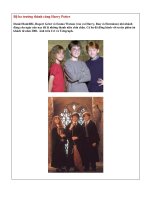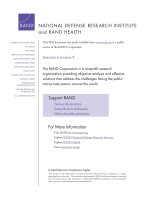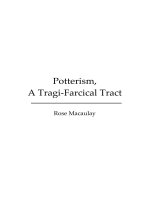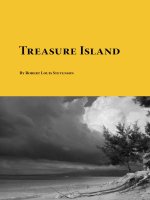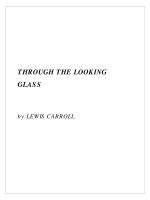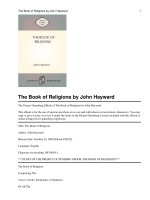COPYRIGHTSAND COPYWRONGS pot
Bạn đang xem bản rút gọn của tài liệu. Xem và tải ngay bản đầy đủ của tài liệu tại đây (12.62 MB, 256 trang )
COPYRIGHTSAND COPYWRONGS
SIVA VA
I
D
H
YA
N
AT
H
A
N
COPYRIGHTSAND COPYWRONGS
The Rise
of
Intellectual Property
and How It
Threatens Creativity
II
New York University Press
• NewYork and London
NEW YORK UNIVERSITY PRESS
New York and London
© 2001 by New York University
All rights reserved
Library of Congress Cataloging-in-Publication Data
Vaidhyanathan, Siva.
Copyrights and copywrongs : the rise of intellectual property and
how it threatens creativity / Siva Vaidhyanathan.
p.
cm.
Includes bibliographical references and index.
ISBN 0-8147-8806-8 (alk. paper)
1.
Copyright—Social aspects—United States. 2. Copyright—United
States—History. 3. United States—Cultural policy. I. Title.
Z642 .V35 2001
346.7304'82—dc21 2001002178
New York University Press books are printed on acid-free paper,
and their binding materials are chosen for strength and durability.
Manufactured in the United States of America
10 987654321
Contents
Acknowledgments vii
Introduction 1
1 Copyright and American Culture: Ideas, Expressions,
and Democracy 17
2 Mark Twain and the History of Literary Copyright 35
3 Celluloid Copyright and Derivative Works, or, How to
Stop 12 Monkeys with One Chair 81
4 Hep Cats and Copy Cats: American Music Challenges
the Copyright Tradition 117
5 The Digital Moment: The End of Copyright? 149
Epilogue: The Summer without Martha Graham 185
Notes 191
Index 231
About the Author 243
v
My greatest debt is to Shelley Fisher Fishkin. She has been an ideal men-
tor throughout my brief career and will continue to inspire my explo-
rations for years to come. As Professor Fishkin exemplifies, there is no
warmer social and intellectual support system than the circle of Mark
Twain scholars around the world. Victor Doyno and Robert Hirst en-
thusiastically encouraged me to pursue Twain's interest in copyright,
and each opened up many invaluable opportunities. Louis J. Budd and
David E. E. Sloane were early and constant supporters of my interests
in American humor. Joe Alvarez, Gregg Camfield, Andrew Hoffman,
Michael Kiskis, McAvoy Layne, Bruce Michelson, R. Kent Rasmussen,
Taylor Roberts, Laura Skandera-Trombley, David L. Smith, Jeffrey
Steinbrink, Tom Tenney, Harry Wonham, Judith Yarros-Lee, and Jim
Zwick generously gave me their advice, support, and friendship.
I owe special thanks to Jervis Langdon Jr. for making the Elmira
College Center for Mark Twain Studies and Quarry Farm a hospitable
and valuable site for scholars. I am honored that the center allowed me
to serve as a scholar-in-residence during the summer of 1997. Karen
Ernhout, Michael Kiskis, Gretchen Sharlow, and Mark Woodhouse
made my stay in lovely Elmira fruitful and fun. It's no wonder Mark
Twain did his best work there—although I suspect he would have been
less productive had he had cable television.
I am deeply indebted to both Robert Hirst and Victor Doyno for
their help and advice in reading, transcribing, examining, and dis-
cussing "The Great Republic's Peanut Stand." I must thank Margalit
Fox of the New York Times for helping bring Mark Twain's "The Great
Republic's Peanut Stand" to the attention of the world, and helping to
put copyright discussions on the national agenda.
I have had the pleasure of discussing copyright issues with some
outstanding legal scholars in the process of composing this project:
Yochai Benkler, June Besek, Michael Birnhack, Andrew Chin, Julie
Cohen, William Forbath, Jane Ginsburg, Mike Godwin, Peter Jaszi,
vii
viii ACKNOWLEDGMENTS
David Lange, Mark Lemley, Lawrence Lessig, Neil Netanel, Beth Si-
mone Noveck, and Jonathan Zittrain. The work of James Boyle, Rose-
mary Coombe, Margaret Radin, and Pamela Samuelson has inspired
me to voice the case for the public interest in copyright policy.
For feedback and intellectual inspiration, I owe Chuck D., John
Perry Barlow, and Richard Stallman a great deal. Discussions with Jello
Biafra and John Flansburgh about copyright and the music industry
have influenced this book as well.
The faculty and staff at the Berkman Center for Internet and Society
at Harvard Law School included me in its programs and kept me in-
formed of evolving issues. The Open Law experiment, in particular,
was a great help.
Authors don't thank librarians and teachers enough. This project
could not have been written without the help of librarians at Wesleyan
University, the State University of New York at Buffalo, Elmira College,
the Library of Congress, the University of California at Berkeley, Cor-
nell University, the Buffalo and Erie County Public Library, Yale Uni-
versity, the University of Illinois at Urbana-Champaign, the University
of Texas at Austin, and New York University. Librarians in the Williams-
ville Central School District, especially Joyce Zobel, taught me how to
read.
Williamsville teachers such as Mildred Blaisdell, Regina Derrico,
and Sue Holt taught me how to write.
I particularly need to thank New York University librarian Nancy
Kranich and the staff of the American Library Association. Being the
custodians of our information and cultural commons, librarians took an
early interest in my work. I look forward to many years of working with
them. Also, the staff and officers of the Electronic Frontier Foundation
have been helpful in allowing me to participate in public discussions
about copyright issues and the electronic information environment.
I have presented portions of this work before sessions of the Amer-
ican Literature Association, the American Studies Association, the
Modern Language Association, the New York State Communication
Association, and the American Studies Association of Texas. At my side
through many of those sessions were Melissa Homestead and David
Sanjek. Their input was invaluable to the intellectual journey this sub-
ject has taken me on. I also presented portions of this project before fac-
ulty and students at the University of Texas, Wesleyan University, New
York University, Harvard University, the New School University, and
ACKNOWLEDGMENTS ix
Brown University. The feedback I received at these institutions was
invaluable.
At the University of Texas, I owe particular thanks to the following
people, some of whom have moved on to other institutions: Robert
Berdahl, Walter Dean Burnham, Sheldon Ekland-Olson, Peter Flawn,
Neil Foley, Ron Gibson, Lewis Gould, Robert Hardgrave, Robert King,
Richard Lariviere, Gail Minault, David Montejano, Adam Newton, Pat-
rick Olivelle, and Kamala Visweswaran.
The American Studies Department at the University of Texas sup-
ported me in every way possible. My time in the graduate program ex-
tended across terms of two excellent chairs, Robert Abzug and Jeff
Meikle. They both handled departmental business with warmth, hu-
mor, skill, and patience. Bill Stott first suggested I pursue an academic
career, and I will always be grateful for his early and constant friend-
ship and support. Thanks also to Janice Bradley, Patricia Burnham, Al
Crosby, Janet Davis, Desley Deacon, Cynthia Frese, Lydia Griffith, Mel-
anie Livingston, and Mark Smith for their wonderful advice and sup-
port. My peers through graduate school taught me as much as anyone
did.
My dissertation committee read an early version of this work and
gave trenchant advice that helped make it a real book. The committee
included Kevin Gaines, William Forbath, Neil Netanel, Jeff Meikle,
Robert M. Crunden, and Shelley Fisher Fishkin. A special acknowledg-
ment goes to the memory of Professor Crunden, who passed away soon
after the dissertation defense. During my time in the graduate program,
he challenged me at every turn. He never let me get away with merely
passable work.
I wrote much of this book during a wonderful year at Wesleyan
University. The following people were responsible for making that
year highly productive: Jonathan Cutler, Jeff Kerr-Ritchie, Donna Mar-
tin, Jim McGuire, Eliza Petrow, Claire Potter, Renee Romano, Ashraf
Rushdy, Kate Rushin, Peter Rutland, and Jennifer Tucker. Donna Mar-
tin retired as my year at Wesleyan ended. She will go down in history
as one of those rare and legendary administrators who can slash
through the thickest bureaucracy with a single phone call.
At New York University this book has benefited from encourage-
ment and feedback from Trish Anderson, Amy Bentley, Deborah Boris-
off, Lane Browning, Jonathan Burston, Robin Means Coleman, Todd
Gitlin, Dan Hahn, John Lang, Ted Magder, Elizabeth McHenry Mark
X
ACKNOWLEDGMENTS
Crispin Miller, Christine Nystrom, Neil Postman, Arvind Rajagopal, Jay
Rosen, Mitchell Stephens, Aurora Wallace, Ellen Willis, and Marion
Wrenn. Neil Postman was a particularly important figure in the com-
position of this book. His leadership of the Department of Culture and
Communication ensured I had the time and resources to research and
write this book. But more than that, Neil's friendship has been a great
boon to my life in the Big City. Neil is a combination of Obi-Wan Kenobi
and Casey Stengal. His wit, charm, and brilliance have made my time
at NYU a pleasure.
I have tried to follow the examples of other scholarly and experi-
mental works intended to enrich democracy: James Fishkin's delibera-
tive polls; James Carey's essays that explain how communication cre-
ates culture; and Jay Rosen's efforts to instill a sense of public duty
among journalists. In the spirit of John Dewey, Fishkin, Carey, Rosen,
and others have argued for and described ways to make the American
public sphere richer and more meaningful. I hope this book can con-
tribute to that effort.
My students at Concordia University at Austin, the University of
Texas, Wesleyan University, and New York University have taught me
more than I could ever have taught them.
My former life as a journalist gave me many friends and role mod-
els,
especially Molly Ivins. Katrina vanden Heuvel and Art Winslow at
the Nation allowed me to present my views of the Napster controversy
in a timely manner. Rick Karr at National Public Radio has been a valu-
able sounding board for my thoughts on technology and music. Rob
Walker at Slate kept me honest.
Many friends offered encouragement and support through the exe-
cution of this book. They include Karen Adams, Leah Archibald, Josh
Brewster, Diane Burch Beckham, Joe Belk, Catherine Collins, John
Council, John Fitzpatrick, Catherine Haddad, David McBride, Mark
McCulloch, Joe Mendelson, Sue Murray, David Nather, Dan O'Neill,
Karl and Lisa Pallmeyer, Bob Randall, Catherine Simmons, Greg
Speller, Paula Stout, Karine Walther, and Michelle Valek. Among these
friends, Sue Krenek deserves special notice for suggesting I write about
the intersections of copyright and culture in the first place. Blame her
for fueling my hubris.
In the American Studies community, Gena Caponi-Tabery Joel Din-
erstein, Kim Hewitt, Charlie Keil, Brett Gary, John Gennari, David
Roediger, and Carlo Rotella encouraged me at every turn.
ACKNOWLEDGMENTS xi
At New York University Press, Niko Pfund sought out this book
with his characteristic energy and passion. After Niko left NYU Press
for a higher station, Eric Zinner took this book through editing and pro-
duction without missing a step. Composing a first book is a frightening
process. I am glad I had their guidance and confidence at every step.
The phrase "a gentleman and a scholar" must have been invented
to describe my patient and generous father, Vishnampet Sivaramakrish-
nan Vaidhyanathan. I have surrounded myself with the brilliant and
talented, yet he still counts as the smartest person I have ever known.
My mother, Virginia Vaidhyanathan, showed me the world and taught
me not to fear it. The love of my sisters, Mehala and Vedana, kept me
working during the hardest moments. Although my dear grandparents,
Vedambal and V. M. Sivaramakrishnan, could not stay around long
enough to read this book, I know they can feel it. They also can sense
my love and appreciation for their children, grandchildren, and great-
grandchildren. And to my dear remaining grandparent, Helen Evans:
thanks for making everything possible, even when things seemed im-
possible. Your love means more than you could ever know.
Vanity of vanities, saith the preacher; all is vanity.
And moreover, because the preacher was wise, he still taught the
people knowledge; yea, he gave good heed, and sought out, and set in
order many proverbs.
The preacher sought to find out acceptable words: and that which
was written was upright, even words of truth.
The words of the wise are as goads, and as nails fastened by the
masters of assemblies, which are given from one shepherd.
And further, by these, my son be admonished: of making many
books there is no end; and much study is a weariness of the flesh.
—Ecclesiastes, 12:8-12
IN I946.GROUCHO Marx received a letter from the legal department
of Warner Brothers studios. The letter warned Marx that his next film
project, A Night in Casablanca, might encroach on the Warners' rights to
their 1942 film Casablanca. The letter prompted a reply from Marx that
ridiculed many of the operational principles of rights protection in the
film industry. First, Marx expressed surprise that the Warner Brothers
could own something called "Casablanca" when the name had for cen-
turies been firmly attached to the Moroccan city. Marx declared that he
had recently discovered that in 1471 Ferdinand Balboa Warner, the
great-grandfather of the Warners, had stumbled upon the North Afri-
can city while searching for a shortcut to Burbank. Then Marx pondered
how the filmgoing audience could possibly confuse the Marx Brothers
project with the widely successful Warner Brothers production. Ameri-
can filmgoers, Marx argued, could probably distinguish between Casa-
blanca star Ingrid Bergman and his blond brother Harpo Marx. "I don't
know whether I could [tell the difference]," Marx added, "but I cer-
tainly would like to try."
1
i
2 INTRODUCTION
Then Marx turned the issue of name ownership on the Warners. He
conceded that they could claim control of "Warner," but certainly not
"brothers." Marx claimed, "Professionally, we were brothers long be-
fore you were." Marx pointed out that even before the Marx Brothers,
there were the Smith Brothers, the Brothers Karamazov, Detroit Tigers
outfielder Dan Brothers, and "Brother, Can You Spare a Dime?" which
Marx asserted was originally plural, "but this was spreading a dime
pretty thin, so they threw out one brother." Marx asked Jack Warner if
he was the first "Jack," citing Jack the Ripper as a possible precursor.
Marx told Harry Warner that he had known several Harrys in his life,
so Harry Warner might have to relinquish his title as well. Marx con-
cluded his letter with a call for solidarity among "brothers" in the face
of attacks from ambitious young lawyers who might seek to curb their
creative activities. "We are all brothers under the skin and we'll remain
friends till the last reel of 'A Night in Casablanca' goes tumbling over
the spool."
2
The Warner Brothers legal department wrote back to Marx several
times, asking for a summary of the plot of A Night in Casablanca so the
lawyers could search for any similarities that might be actionable. Marx
replied with a ridiculous plot summary about brother Chico Marx liv-
ing in a small Grecian urn on the outskirts of the city. The legal depart-
ment again wrote for more detail. Marx answered by saying he had sub-
stantially changed the plot of the film. The new story involved Groucho
Marx playing a character named Bordello, the sweetheart of Humphrey
Bogart, and Chico running an ostrich farm. Marx received no more let-
ters of inquiry from the Warner Brothers legal department.
3
In his responses to the Warner Brothers legal department, Marx
made several points about mid-century trends in "intellectual prop-
erty." These trends have grown more acute in the last decade and
presently threaten creativity and access to information. American copy-
right law at the beginning of the century tilted in favor of consumers at
the expense of producers. In an attempt to redress that antiproducer im-
balance, courts, the U.S. Congress, and international organizations have
succeeded in tilting the body of law dangerously the other way. Grou-
cho Marx is gone, but Time Warner, Inc., is more powerful than ever.
Since the release of A Night in Casablanca, information, entertain-
ment, and computer software have emerged as among the United
States' most valuable resources and most profitable exports. Yet the
legal system that supports and guides those resources, "intellectual
INTRODUCTION 3
property law," remains the murkiest and least understood aspect of
American life and commerce. The rules seem to change every few years,
yet remain a step behind the latest cultural or technological advances.
Ignorance of the laws and fear of stepping over gray lines intimidate
many artists, musicians, authors, and publishers. Meanwhile, copyright
libertarians flaunt the difficulty of enforcement over the nation's com-
puter networks, and rap musicians lift samples of other people's music
to weave new montages of sound that have found a vibrant market. In
recent years, the following phenomena have complicated the discus-
sion over what sorts of "borrowing" and "copying" are allowed or for-
bidden under intellectual property standards:
• Rap stars 2 Live Crew parodied Roy Orbison's song "Oh, Pretty
Woman." Orbison's licensing company, Acuff-Rose, sued the rap
group, alleging that the new recording was not a true parody
and thus was not protected by the "fair use" provision of the
copyright law.
• In an airport, artist Jeff Koons spotted a picture postcard of a sub-
urban couple hugging a litter of puppies. He instructed his un-
derstudies to build a sculpture of the couple and paint them
ridiculous colors. Koons sold the sculpture to a museum, but the
photographer sued him for copyright infringement and won.
The photographer now has possession of the sculpture as part of
the settlement.
• The U.S. government has pressured the Chinese government to
crack down on publishers and vendors who issue unauthorized
versions of American music, literature, and computer software.
• Motion picture companies in the 1970s urged the U.S. Congress
to restrict the sale of video cassette recorders in the United States,
fearing that duplication of films would limit first-run movie
profits. After losing the antivideo battle in Congress and in the
courts, the industry embraced the technology and opened up a
whole new sector for redistributing its products. Then, in 2000,
the industry again lowered heavy legislative and legal hammers
to stifle a technology that allows unauthorized private, noncom-
mercial access to and copying of digital video discs.
• Record companies in the 1980s stalled the introduction of digital
audio taping equipment into the consumer market, fearing high-
quality home musical copying would limit compact disc sales.
4 INTRODUCTION
Then, in the spring of 2000, the recording industry initiated a
slew of legal actions to restrict the proliferation of file-sharing
services such as Napster, through which fans can share com-
pressed music files.
• Apple Computer Corporation unsuccessfully sued Microsoft
Corporation for copyright infringement. Apple accused the soft-
ware giant of illegally basing its Windows format on Apple's
Macintosh graphical user interface design.
All of these issues go deeper than the tangle of statutes and court deci-
sions that weave the mesh of copyright law. They expose and depend
on American ethical assumptions and cultural habits, including the no-
tions of rewarding hard work, recognizing genius and creativity, ensur-
ing wide and easy access to information, and encouraging experimen-
tation in both art and commerce. More deeply, these issues raise ques-
tions about whether American culture, with its African American and
American oral traditions and anti-authoritarian predispositions, can
broadly deploy a legal framework drawn up by British noblemen three
centuries ago. As American expressive culture becomes more techno-
logically democratic, more overtly African American, more global and
commercial, the archaic legal system it inherited has been remarkably
able to accommodate all these changes, however imperfectly. The story
of copyright law in the twentieth century has been the process of ex-
panding, lengthening, and strengthening the ill-fitting law to accom-
modate these changes. Gradually the law has lost sight of its original
charge: to encourage creativity, science, and democracy. Instead, the
law now protects the producers and taxes consumers. It rewards works
already created and limits works yet to be created. The law has lost its
mission, and the American people have lost control of it.
4
WHO IS COPYRIGHT FOR?
As a result of these and other cases, digital reproduction, international
commerce, and digital music sampling have exposed gaps in the law's
ability to deal with new forms of production and new technologies.
Powerful interests have argued for stronger restrictions that intimidate
artists, musicians, and computer hobbyists into respecting "property
rights" at the expense of creative liberty. Others have abandoned all
INTRODUCTION 5
hope of legally constraining piracy and sampling, and have instead ad-
vocated a system of electronic locks and gates that would restrict access
to only those who agree to follow certain strict guidelines.
This book argues against both those positions. Through a series of
case studies in different media through the twentieth century, it argues
for "thin" copyright protection: just strong enough to encourage and re-
ward aspiring artists, writers, musicians, and entrepreneurs, yet porous
enough to allow full and rich democratic speech and the free flow of in-
formation. The book opens with an examination of Mark Twain's role in
defining the terms of debate for literary copyright in the first decade of
the century. It will then show how some key Supreme Court decisions
brought the new media of film and recorded music under the copyright
umbrella, poking a hole in the wall that separated the protection of spe-
cific expression and the freedom to use others' ideas. The experiences of
jazz and blues composers flesh out the complexities of how the law han-
dles "works made for hire" and the ethnic politics at work in issues of
ownership and control of American popular music. The book will then
use rap music to explore how postmodern sensibilities and new tech-
nologies have exposed deep flaws in the law. Finally, it will examine
some disturbing trends in international "intellectual property" law that
may fundamentally change how American literature, music, film, soft-
ware, and information will be produced, bought, sold, and used in the
twenty-first century.
The chief goal of this work is to explain how essential the original
foundations of American copyright law are to our educational, political,
artistic, and literary culture. Lately as a result of schools of legal
thought that aim to protect "property" at all costs and see nothing good
about "public goods," copyright has developed as a way to reward the
haves: the successful composer, the widely read author, the multina-
tional film company. Copyright should not be meant for Rupert Mur-
doch, Michael Eisner, and Bill Gates at the expense of the rest of us.
Copyright should be for students, teachers, readers, library patrons, re-
searchers, freelance writers, emerging musicians, and experimental
artists. Because the body of law has grown so opaque and unpredictable
in recent years, copyright policy discussion has resided in the domain
of experts who have the time and money to devote to understanding
and manipulating the law. Copyright myths have had as much power
as copyright laws. The interests of the general public have been ignored
by the movements to expand copyright in the 1990s. Organizations of
6 INTRODUCTION
librarians and scientists have taken stands against odious policy pro-
posals, but they are matched against lawyers for Microsoft and Disney.
It is not a fair fight. My prescription for this problem is to bring the dis-
cussion of copyright issues into the public sphere, where it once was.
5
As literary historian Michael Warner explains in his book The Let-
ters of the Republic, the idea of a public sphere was central to early Amer-
ican republican ideology, the same ideology that produced and justified
American copyright law. The emergence of an independent press cul-
ture enabled the development of a public sphere and allowed those
who were sanctioned to participate in it (literate white males) to simul-
taneously criticize the state and commercial culture. Not coincidentally
Warner argues, late-eighteenth-century American print culture was the
site of shifting and emerging definitions of terms such as "individual,"
"print," "public," and "reason." All of these terms lend themselves to
the foundations of American copyright law. So this project builds upon
Warner's: the eighteenth-century public sphere was essential to the es-
tablishment of copyright law, and copyright's subsequent transforma-
tions coincide with the general structural transformation of the public
sphere. A cycle has developed. The corruptions of copyright have en-
forced, and been enforced by, the erosions of the public sphere.
6
Five decades before Jurgen Habermas described the structural
transformation of the public sphere in the twentieth century, Walter
Lippmann and John Dewey sensed these changes as well. They each
prescribed different and opposing treatments for what ailed—and still
ails—American society. In Public Opinion (1922), Lippmann described
the failure of the liberal republican model of communication. He ar-
gued that the world in the twentieth century had grown so complex and
diffuse, and questions of public concern required so much specialized
knowledge, that the general public was unable to deal with issues in-
telligently or efficiently. Mass communications by the 1920s had ceased
operating as the site of dependable or substantial information about the
world. Instead, Lippmann asserted, all that most readers could discern
from the mass media was a series of confusing "stereotypes," fuzzy and
distorted "pictures in our heads." Lippmann believed that "true," de-
pendable, and useful information was fixable and usable, but only if a
class of experts could filter, edit, and certify the information first. This
priestly class of educated experts, Lippmann argued, should have a
central role in all discussions and decisions of public policy. It should
guide, if not determine, public opinion. In other words, Lippmann
INTRODUCTION 7
sensed that the republican public sphere had eroded. He argued that an
elite state council could replace it. Lippmann wanted to shift the duties
of the public sphere to the state itself 7
John Dewey reviewed Lippmann's Public Opinion in the New Re-
public in 1922. Five years later, Dewey assembled a broad indictment of
Lippmann's ideas in the book The Public and Its Problems (1927). Recog-
nizing that such a council of Brahmin experts would threaten real
democracy, Dewey instead called for a reinvigoration of local public
spheres. The public should be better educated to be able to distinguish
between solid description and mere stereotypes, Dewey argued, and a
broader cross-section of the public must be included in the public
sphere. "We lie, as Emerson said, in the lap of an immense intelligence,"
Dewey wrote. "But that intelligence is dormant and its communications
are broken, inarticulate and faint until it possesses the local community
as its medium."
8
Alas,
Dewey lost the battle. American political culture since Lipp-
mann's Public Opinion has been marked by steady centralization and
corporatization of information and access. Experts have simultaneously
assumed control of the information necessary for decision making and
increased their influence over the means of exercising power. While the
electorate has structurally expanded through civil rights legislation, po-
tential voters protest their disconnection from the process of decision
making by recusing themselves. Occasionally, technological innova-
tions such as the Internet threaten to democratize access to and use of
information. However, governments and corporations—often through
the expansion of copyright law—have quickly worked to correct such
trends. Therefore, considering copyright issues as a function of the fail-
ure of the public sphere simultaneously reveals the poverty of the pub-
lic sphere and the ways in which a healthy public sphere would depend
on "thin" copyright policy.
Copyright policy is set through complex interactions among a vari-
ety of institutions. International organizations, federal agencies, Con-
gress, state legislatures, law journals, private sector contracts, and the
habits of writers, artists, and musicians all influence the operation of the
copyright system. Often these forums operate without sufficient under-
standing of the "big picture" of the copyright system: its role, purpose,
and scope. Seldom are copyright issues adequately examined through
the instruments that might contribute to a healthy public sphere—mag-
azines, newspapers, and popular books.
8 INTRODUCTION
There is no "left" or "right" in debates over copyright. There are
those who favor "thick" protection and those who prefer "thin." At the
extreme margins there are property fundamentalists and there are lib-
ertarians. Some believe that copyright is an artificial and harmful mo-
nopoly that should be destroyed or at least ignored. There are those
who consider copyright a natural right, one that morally derives from
the very act of imagining and creating. Others believe copyright should
adhere to a "labor" theory of value: investing effort and adding value to
a previous work or set of data should generate legal protection. And
some others adhere to the position argued in this book: copyright is the
result of a wise utilitarian bargain, and it exists to encourage the invest-
ment of time and money in works that might not otherwise find ade-
quate reward in a completely free market. There are costs and benefits,
winners and losers in every policy act. Examining these costs and ben-
efits,
and publicly debating them, can yield a more just and efficient
copyright system, and possibly a more dynamic culture and democracy.
SHIFTING THE FOCUS
This book has another mission: to shift the terms of discussion about
copyright in scholarly circles from the theoretical to the empirical. In
other words, I want to move the debate away from such metaphysical
concepts as whether an autonomous "author" exists, whether such a
being could produce a stable "text" or "work," and whether that text
could be in any measurable way "original." These are all interesting
questions, but they are questions that can fade from significance if we
consider actual incidents of human beings creating, labeling, and sell-
ing books, songs, or sculptures. As we can see from examining the prod-
ucts we associate with Mark Twain, Willie Dixon, and Bill Gates, "au-
thorship" is theoretically suspect, texts are unstable and determined in
large part by their readers, and originality is more often a pose or pre-
tense than a definable aspect of a work. Scholars such as Cathy David-
son, Martha Woodmansee, Mark Rose, Peter Jaszi, and David Sanjek
have shown us that the questions Roland Barthes and Michel Foucault
raised about our western notions of authorship are powerful and im-
portant. Yet raising these questions is not sufficient. There is much more
work to be done.
9
For most people and in most usages, an "author" is an obvious
INTRODUCTION 9
concept. An author is a person who writes something. If prompted,
many people will elaborate on the notion by differentiating a "cre-
ative" author from a mere transcriber. This distinction carries with it
a sense of cultural hierarchy, with the creator on the north side of the
equation. As we will discover later in this work, the distinction yields
legal and commercial differences as well. But these common defini-
tions and distinctions have come under severe scrutiny by philoso-
phers and literary theorists.
French literary theorist Roland Barthes, in a 1968 essay called "The
Death of the Author," opened a line of exploration that means to un-
derstand how European and American literary culture has arrived at its
common definitions and system of rewards for an author. Barthes wrote
his essay to urge a shift in critical attention away from the human being
who readers imagine stands above the action of a work, tugging on nar-
rative marionette strings. Barthes defined this imagined "author" as the
sum of the assumptions of psychological consistency, meaning, and
unity that readers and critics had traditionally imposed on a text.
Counter to the traditional understanding of authorship, Barthes called
for a different way of understanding the process of reading: as a game
played entirely by the reader. The reader or critic, not the author, pro-
duces the meaning of the text, Barthes argued. By taking the historical
or biographical author out of the search for meaning in a text—by
killing the author—Barthes empowered the reader within the environ-
ment of textuality.
10
In response to Barthes, philosopher Michel Foucault redefined—
and thus revived—the author as a relevant, if not imperative, function
of reading, criticism, and literary analysis. To do this, Foucault imag-
ined a culture in which the idea of an "author" would be dead. Foucault
noted that without a legal definition of an "author," the language of crit-
ical discourse would lack its operational vocabulary and habits of
analysis. Without a name to attach to a work, no one could be held ac-
countable for the content and ramifications of the work. Foucault's au-
thor, one who could be held accountable, is a legally prescribed and de-
scribed entity, not necessarily a flesh-and-blood human being, and cer-
tainly not exclusively a brooding romantic "genius," toiling in darkness
and channeling a muse. An author is not just a "writer" for Foucault.
Graffiti on a bathroom wall has a writer, Foucault noted, but not an au-
thor. The law and thus the culture use the idea of an "author," even if it
is merely a proper name, as a locus for a complex network of activities
10 INTRODUCTION
and judgments that deal with ownership, power, knowledge, expertise,
constraints, obligations, penalties, and retribution. Foucault defined the
author as a legal and cultural function, but one that matters deeply to
how a culture understands, uses, and is manipulated by texts. So for
Foucault, the author matters. But it matters for what it does in a culture,
not necessarily whom it represents. This depersonalized "author-func-
tion" has four traits. It is linked to the legal system that regulates dis-
course within a culture. It operates differently in different cultures. An
"author" does not precede a "work" (much as for Jean-Paul Sartre's
human being, essence does not precede existence), but comes into being
only as it functions in a legal and cultural environment. Lastly, it repre-
sents not simply an actual identifiable human being but perhaps several
independent, contradictory, or conflicting identities.
11
What do we do about "authorship" once we have labeled it "con-
structed"? How does such a label help us build a more democratic
system for the exchange of cultural production? How does it help us
encourage new and emerging artists and musicians against the over-
whelming force of companies like Microsoft, Time Warner, and Walt
Disney? We can deconstruct the author for six more decades and still
fail to prevent the impending concentration of the content, owner-
ship,
control, and delivery of literature, music, and data. As law pro-
fessor Mark Lemley has argued, attacking the bogeyman of "roman-
tic authorship" is misguided because romantic authorship neither ex-
plains many of the most important changes in copyright law over the
past two hundred years nor prescribes a way to improve the ways
copyright law works.
12
A seventeen-year-old mixing rap music in her garage does not care
whether the romantic author is dead or alive. She cares whether she is
going to get sued if she borrows a three-second string of a long-forgot-
ten disco song. We must get beyond such esoteric discussions about
the rise of the romantic author. Instead, we should define an "author"
broadly, as a cultural entity: a "producer." Since 1909, the copyright
statute has recognized this broad sense of authorship, the "unromantic"
author. The unromantic author might be a young rapper with a $2,000
MIDI sampling machine or a corporation like Disney, through a team of
writers working on the cartoon version of Don Quixote. American copy-
right law itself undermines any romantic sense of individual genius. It
recognizes both Microsoft and Miles Davis as authors in a legal sense.
The law has changed over the course of the century to create that spe-
INTRODUCTION I I
cial legal entity that in fact has little or nothing to do with a personified
"author" as we traditionally imagine. Still, we must deal with the "pro-
ducer" in some form, in court if nowhere else.
THE CASE AGAINST "INTELLECTUAL PROPERTY" TALK
From the middle of the nineteenth century, those who have pushed to
enlarge and deepen copyright protection have invoked the need to pro-
tect authors from "theft." As we shall see in the chapters to come, some
of those claims were warranted, and the U.S. Congress adjusted the
laws to deal with these problems. However, since 1909, courts and cor-
porations have exploited public concern for rewarding established au-
thors by steadily limiting the rights of readers, consumers, and emerg-
ing artists. All along, the author was deployed as a straw man in the
debate. The unrewarded authorial genius was used as a rhetorical dis-
traction that appealed to American romantic individualism. As copy-
right historian Lyman Ray Patterson has articulated, copyright has in
the twentieth century really been about the rights of publishers first, au-
thors second, and the public a distant third. If we continue to skewer
this "straw man" of authorship with our dull scholarly bayonets, we
will miss the important issues: ownership, control, access, and use.
It is essential to understand that copyright in the American tradi-
tion was not meant to be a "property right" as the public generally
understands property. It was originally a narrow federal policy that
granted a limited trade monopoly in exchange for universal use and ac-
cess.
Lately, however, American courts, periodicals, and public rhetoric
seem to have engaged almost exclusively in "property talk" when dis-
cussing copyright. The use of "property" as a metaphor when consid-
ering copyright questions is not new. The earliest landmark cases in
British copyright discuss "the great question of literary property."
13
And as we will see, Mark Twain invoked property talk to shift the de-
bate away from what was good for America at large to what would ben-
efit successful authors. However, throughout the eighteenth and nine-
teenth centuries in both England and the United States, property talk
was balanced and neutralized by policy talk—a discussion of what is
best for society.
The phrase "intellectual property" is fairly young. Mark Lemley
writes that the earliest use of the phrase he can find occurs in the title of
12 INTRODUCTION
the United Nations' World Intellectual Property Organization, first as-
sembled in 1967. Soon after that, the American Patent Law Association
and the American Bar Association Section on Patent, Trademark, and
Copyright Law changed their names to incorporate "intellectual prop-
erty." Over the past thirty years, the phrase "intellectual property" has
entered common usage with some dangerous consequences.
14
What happens when all questions of authorship, originality, use,
and access to ideas and expressions become framed in the terms of
"property rights"? The discussion ends. There is no powerful property
argument that can persuade a people concerned about rewarding
"starving artists" not to grant the maximum possible protection. How
can one argue for "theft"?
Therefore, we must change the terms of the debate once again. If
this book can persuade readers that copyright issues are now more
about large corporations limiting access to and use of their products,
and less about lonely songwriters snapping their pencil tips under the
glare of bare bulbs, maybe it can revive the discussion. Instead of trying
to prevent "theft," we should try to generate a copyright policy that
would encourage creative expression without limiting the prospects for
future creators. We must seek a balance. Historically and philosophi-
cally, "intellectual property" accomplishes neither. The idea and the
phrase have been counterproductive. Instead of bolstering "intellectual
property," we should be forging "intellectual policy."
FROM TWAIN TO 2 LIVE CREW
When and how did "property talk" start dominating American copy-
right discourse? Public and congressional debates over copyright re-
form from 1870 through 1909 set the tone for the rest of the twentieth
century. Because of the work of Mark Twain and others, "property talk"
gained a place in the public imagination. Its power grew steadily after
that. Twain lived and wrote at the moment when copyright issues
leaped off the printed page and into the atmosphere of sight and sound.
At the moment when Twain found reason to applaud the 1909 revision
of the copyright law, American culture and technology rendered it out-
dated once again. The first two decades of the twentieth century saw the
invention of phonographs and recording machines. Ragtime com-
posers, who mastered their art through communal creativity and an
